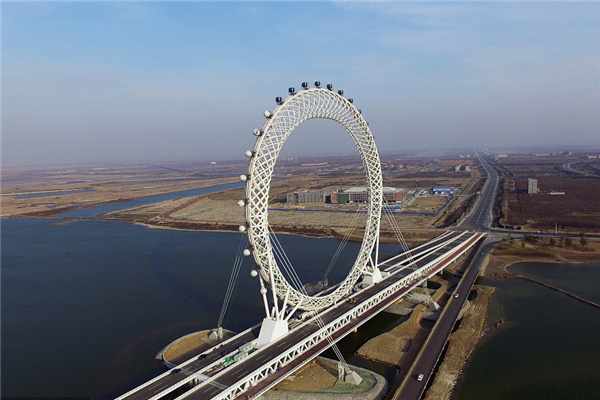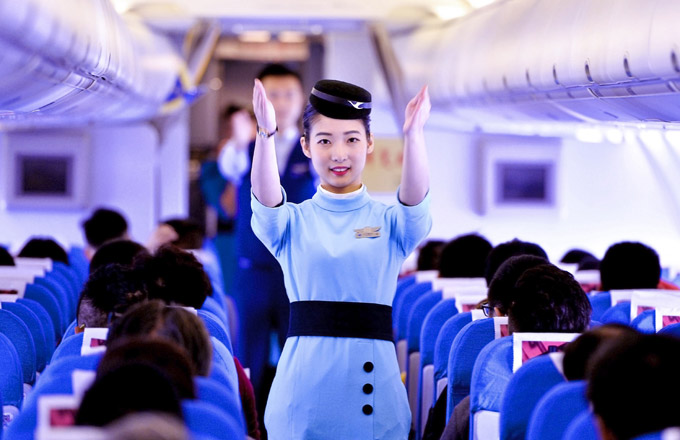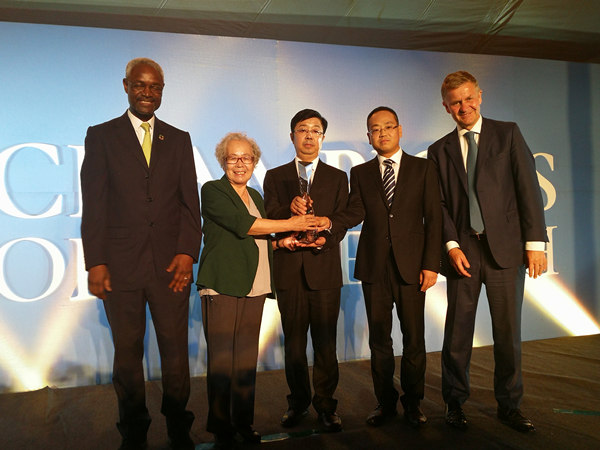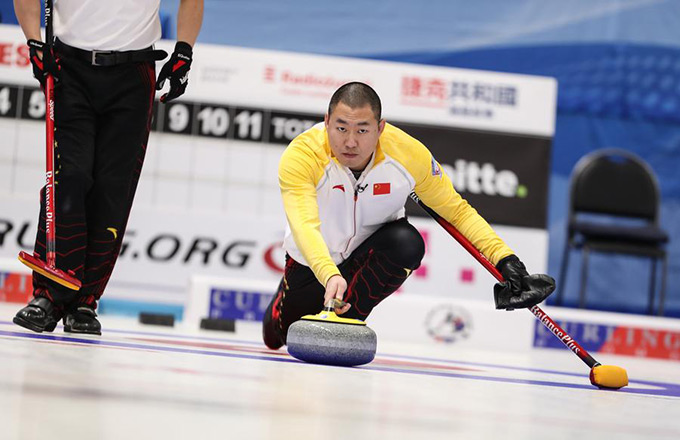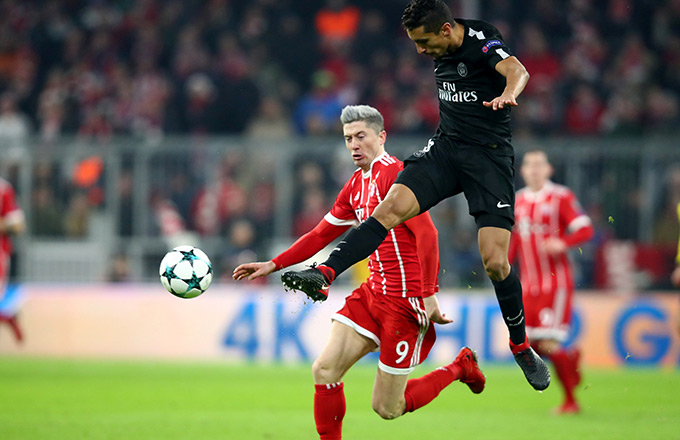

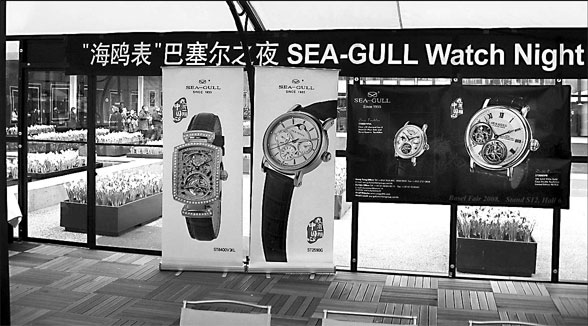
The reputation of China's oldest watch maker, Sea-gull, was on the line in an international arena - in Switzerland no less, a country synonymous with confidential high finance, scenic Alps, posh pocket knives, fine chocolate and, of course, world-class time pieces.
The arena was the BaselWorld watch and jewelry exposition held annually in Basel in April and it was up to Sea-gull to meet a potentially crippling challenge thrown down by a heavyweight Swiss timekeeping firm.
In question was the legal integrity of a "rotary artwork" device on a Sea-gull watch. Known as a dual tourbin, the delicate mechanisms are known for precise time keeping and complicated manual work. Few companies can make the device, but a new Sea-gull watch featured the dual tourbin and claimed a patented special accessory on the dual tourbin called a "planetary transmission" distinguished it from any other watchmakers' works.
On April 5 at 3 pm, representatives from the Swiss watchmaker and a BaselWorld arbitration committee came to the Sea-gull booth to examine the Chinese watchmaker's dual tourbillon design, which the Swiss company believed was pirated.
BaselWorld originally set up an arbitration committee to judge the suspected infringement cases at the exhibition. Any company found of guilty of patent infringement or copying which can't offer enough evidence within 24 hours to the contrary is booted from the exhibition immediately and loses access to the next year's event. Some of them are even sued for compensation and damages.
Wang Deming, general manager of the Tianjin Sea-gull Watch Group Co, sensed the Swiss group's aggressiveness by the interpreter's nervous emotions. It's a battle for my company's reputation now, Wang thought.
Immediately, Wang ordered his staff to collect all the possible evidence and informed the company's lawyer. Meanwhile, the urgent news was quickly passed to Tianjin headquarters where it was midnight.
Feedback from the device's designer partially eased the burden of the Sea-gull staff in Switzerland. In Tianjin, Zhou Wenxia, the main designer told them, "Don't worry. We have applied for a patent for the watch. Before we developed it, we also searched related patents from home and abroad and no infringement was found."
In Basel, a 70-year-old design arbitration expert was carefully scrutinizing the designs of the two companies and found that the Sea-gull model indeed distinguished itself with its "planetary transmission" device.
"Your watch is quite a great work," the arbitration expert said, with his thumb up.
It was the first time that a Chinese company had won any similar challenge in Switzerland. The message that "The Sea-gull watch won" spread quickly throughout the exhibition hall and many attendees rushed to the company's counter to see the disputed watch with their own eyes.
The history of the dual tourbillon in Sea-gull watches can be traced back to 2001. "About seven years ago, I saw a kind of dual tourbillon watch in an international watch exhibition," says Wang. "Later, I decided to make this kind of watch and wear it at an exhibition. After one year, my dream really came true."
Founded in 1955, the Sea-gull brand was the first watch brand made in China. After more than 50 years, China's watch industry now accounts for 70 percent of the world's total output. However, most companies make low profits with original equipment manufacturing (OEM) products, and the gross profit of China's watch Industry occupies only 10 percent in the world.
To build a world-class time keeping brand, Sea-gull has been developing top-grade watches in recent years. Its research team is responsible for 56 patents.
In 2006, the single tourbillon standard was updated to dual tourbillon, which broke up the monopoly of Swiss watch companies. Some local media predicted the technique mastered by Sea-gull would be a key potential challenge for the Swiss watch industry.
In 2007, the company's revenue amounted to 2.98 billion yuan, a 19 percent year-on-year increase. Amid this, Sea-gull's series of tourbillon watches have contributed about 42 percent of the total revenue. The company has maintained doubt-digit growth rate for eight consecutive years.
Nowadays, Sea-gull watches are sold in 14 first-class franchised stores in China metropolises, such as Shanghai, Beijing and Hangzhou. The company also has about 10 retailers in the major Swiss tourist cities, including Zurich and Basel. Currently, it is the only Chinese watch brand in Switzerland.
Sea-gull first gained world attention at the 1984 Los Angeles Summer Olympic Games where, as China's first Olympic sponsor, the company featured watches for the Chinese team and other countries.
Wei Jizhong, senior consultant with the Beijing Organizing Committee for the Games of the 2008 Olympiad, says "It was vividly described by the media that a 'Sea-gull' was flying from China to Los Angeles at that time. At the early stage of China's reform and opening-up, the foreign friends were a little shocked to see the watches made in China."
As the Beijing Olympic Games draws near the company is planning to welcome the event in its own way.
"We never forget the athletes that have won glories for China in the Olympic Games. We are inviting some Olympic athletes to Tianjin to promote the Olympic spirit. At that time, Xu Haifeng, (China's first Olympic champion, a 1984 gold medalist in 50 mm free pistol competition) and many other athletes will show in Tianjin, the Olympic host city," says Wang.
Editor's note: The IPR Special is sponsored by the State Intellectual Property Office and published by China Business Weekly. To contact the Intellectual Property Office, the IPR Special hotlines are 8610-64995421 or 8610-64995826, and the e-mail address is ipr@chinadaily.com.cn.
(China Daily 05/03/2008 page9)


